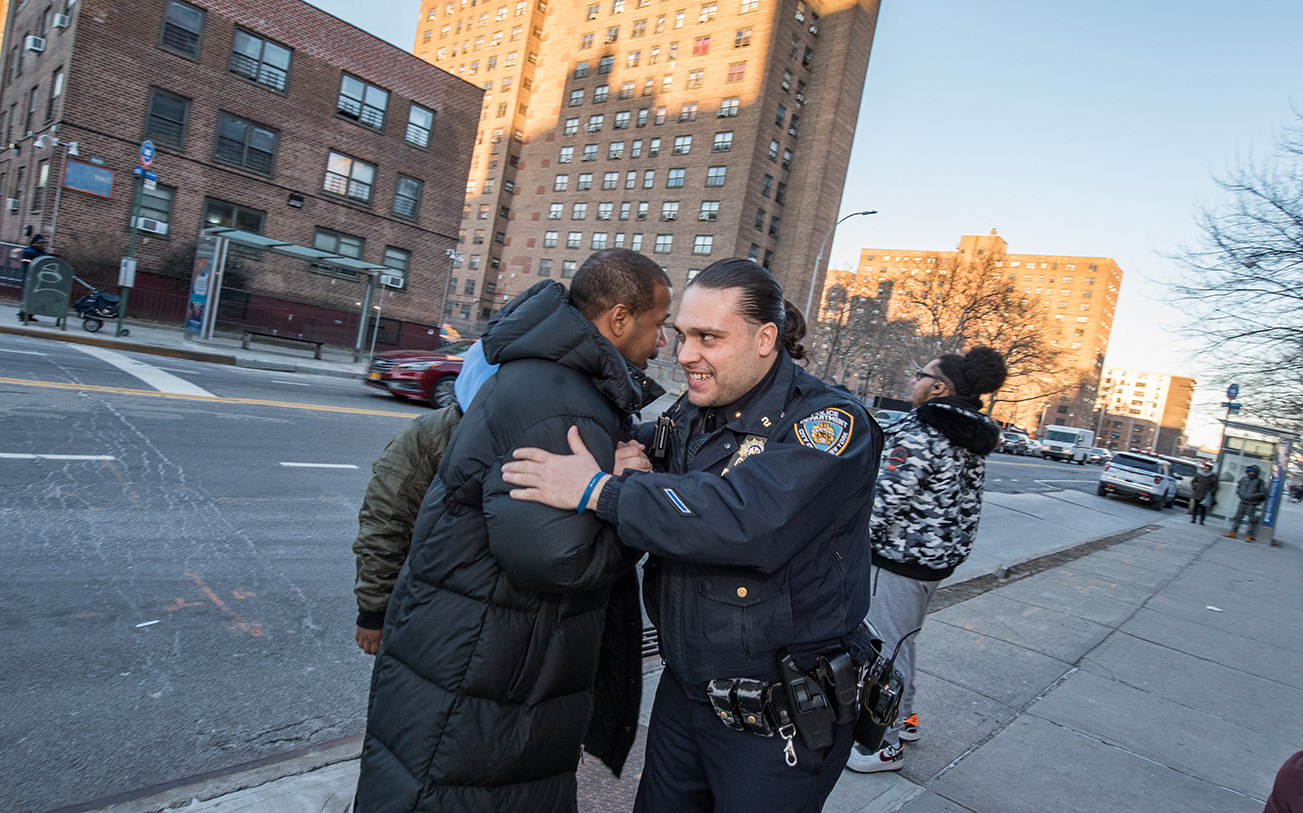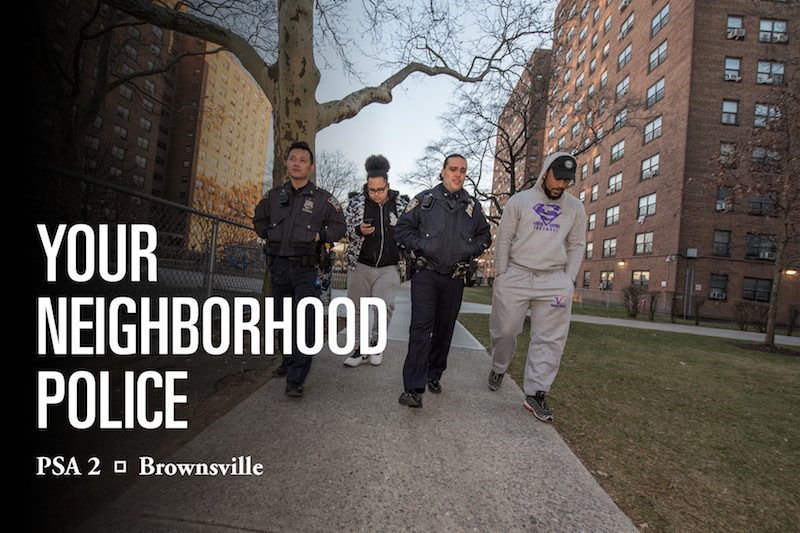Your Neighborhood Police: PSA 2, Brownsville
January 28, 2019
By Edward Conlon
Just inside of the foyer of Police Service Area 2 (PSA 2), a squat, one-story brick building in the Brownsville section of Brooklyn, photos of hundreds of young men cover the walls of a hallway. Printed on ordinary office paper, twenty-five to a page, the pictures are so abundant in number and modest in scale—the size of postage stamps—that they're hard to tell apart. And though a closer look allows a greater appreciation of their individuality, most of the faces share an expression of willful blankness, a hard-eyed refusal to appear anything but hard-eyed.
It is only in the fine print below each photo that a sense of the person starts to emerge. Amid the gray sameness of names, addresses, and dates of birth, the AKAs pop in Technicolor: Shooter Shane, Bullet, Ice, Buck Tooth, Dolla, Bright Eyes, Bloody Trigger, Steph Crush-a-Lot, Young God, Joey Guns, Banga, Smooth, Capone, Man Man, Needles, Sleep. Nicknames are the shortest of stories, but they can shape an entire biography. Most derive from some insider anecdote, or private joke, but once they stick, they can become as conspicuous as tattoos, and just as long-lasting. Some might be self-suggested, or self-declared, or accepted, at least, without complaint: Bullet, Ice, Smooth—Young God, especially—likely have little objection to strangers in the playground overhearing how they're known to their intimates. Buck Tooth? Probably not. But some in the playground might learn the hard way that to call someone Buck Tooth was a privilege, not a right, and if Buck Tooth taught enough people about who could say his name, he might get a more proudly wearable one, like Bloody Trigga or Shooter Shane.
Stepping back from the wall, other differences become clear. Over a hundred pictures are on pages labeled "Cypress Backside" and "Cypress Frontside." Cypress refers to the fifteen seven-story buildings of Cypress Hills Houses, in East New York, in which some 3,300 people reside. Though the two sides have a great deal more in common than not—demographically, economically, geographically—Cypress Backside is claimed by the Crips, and the Frontside by the Bloods, and that can make all the difference in the world.
PSA 2 covers the public housing in three Brooklyn precincts, the 73rd, the 75th, and the 77th, in the neighborhoods of Brownsville, East New York, and Crown Heights. The young men on the wall are members of its major gangs: the Money Petey Gang; the Very Crispy Gangsters, also known as "Weez"; D.O.N., which is short for "Depend on Nobody," Rockstarz, also known as Forever Chasing Money, or Money First; the Cocky Bama Bullies; the Young Gunnaz; O.M.B., for "Only My Brothers"; the Nookie Gang; the Wave Gang; the Brownsville Fresh Gangsters, also known as the Brownsville Money Gang, also known as "Woo." Some of the gang names sound goofy, like the Nookie Gang, and some hint at loneliness and hurt, like Depend on Nobody; all have an air of desperate teen bravado. And though the alliances and rivalries of the gangs are in near-constant flux, they have collectively succeeded in making their neighborhoods among the roughest in the city.
Brownsville, in the 73rd Precinct, may be the roughest of them all. Though there have been many poor neighborhoods in Brooklyn, past and present, Brownsville may be the only one conceived with the specific purpose of keeping its people in poverty. In the late 19th century, factory owners built cheap housing to lure workers away from the Lower East Side, where a burgeoning union movement fought for better conditions and pay. Over time, Brownsville's haphazard development managed to combine dense overcrowding with large amounts of vacant land, which became de facto junkyards. Though it is in east-central Brooklyn, far from the beach, it has always been a kind of island, inward-looking and wary of outsiders. Its two square miles contain some 90,000 people, about a third of whom live in public housing. Its poverty rate is among the highest in the city, at nearly 30 percent, and it has always led in some crime category—in 2018, it was in shootings, with sixty victims, and in the murder rate, at just over fourteen per 100,000 people. Life has never been easy in Brownsville, either when it was a mostly Jewish neighborhood, through the 1950s, or afterward, when it became primarily African American. In 1968, a rancorous teachers strike pitted the two communities against each other, and the scars took long to heal.
Its best known residents have been heavy hitters of one kind or another: gangsters like those of Murder, Incorporated, who are believed to have killed as many as a thousand people in the 1930s and 40s, and boxers like Eddie Mustafa Muhammed, Shannon Briggs, Zab Judah, Danny Jacobs, and Riddick Bowe. And Mike Tyson, who might have had the history of his neighborhood in mind when he observed, "Everybody has a plan until they get punched in the mouth."
*
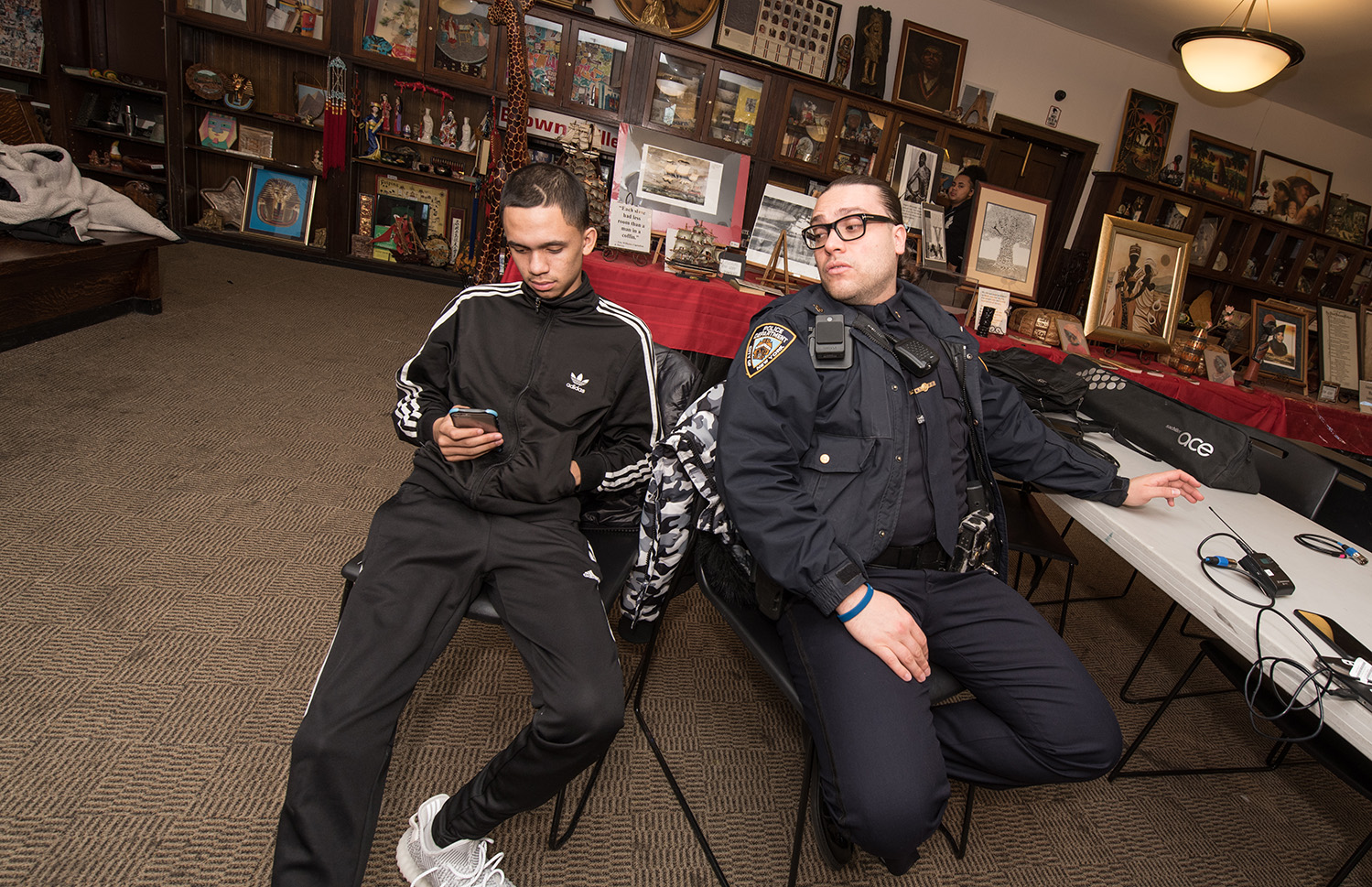
P.O. Jason Anazagasty didn't have a plan when he was assigned to PSA 2, in 2014, but he had an idea that he wanted to work with kids. His mother is a special-ed teacher for the New York City Department of Education, but he didn't see himself in a classroom, at least not yet. Like his late father, Jason loved cars, and he graduated from an automotive program at SUNY Morrisville expecting to work at a car dealership, which he did for a while. He had an uncle named Victor Lebron who was a retired NYPD detective, and he convinced him to take the police test.
"He was in Narcotics, and I loved the stories he told," Jason said. "But I didn't want to do that kind of work. I was more community-oriented. He told me I could do that too with the police. He saw the future of the department, and he told me to get serious about my future."
In Brownsville, Jason started with a fixed post at Howard Houses, as part of Operation Impact, and he became one of the first neighborhood coordination officers (NCOs) the next year, at Van Dyke Houses. Both Howard and Van Dyke are classic mid-century red-brick tower complexes on superblocks: Howard has ten buildings, housing some 2,000 people; Van Dyke has twenty-two buildings, with 4,000 residents. Van Dyke is only three blocks away from Howard, and six other developments—Seth Low, Hughes, Brownsville, Glenmore Plaza, Tilden and Woodson, with a combined population of around 10,000—are even closer. To walk from one development to another requires little physical exertion, but the journey can entail a terrifying measure of physical risk.
When Jason recently looked at the gang-member photos on the wall at PSA 2, he pointed to the photos of the Woo—Ant, Famous Ant, Bandsome Ant, Nice, Spazzo, Bless, Bundles, Baby Finster, Psycho, and Dumbout—he shook his head and said, "There's a lot more of them than they used to be."
The 73rd is one of six precincts designated by Police Commissioner O'Neill as the testing ground of an intensive new crime reduction strategy. Crime has gone down considerably in Brownsville: in 1993, there were seventy-seven murders in the 73rd Precinct; in 2018, there were thirteen. That's still far too many—there were only nineteen homicides on the entire island of Manhattan that year—and the burgeoning portrait gallery reflects a new and disturbing phenomenon.
When Dahshem McFadden was asked about youth violence, he was blunt in his reply: "Things are much worse here than when I grew up."
McFadden is twenty-nine years old, a Brownsville native whose family goes back three generations in the neighborhood. "Besides the crime, I love Brownsville," he said. Few are as rooted in the community as "Coach Mack," as he's known: he was born in Tilden Houses, grew up in Van Dyke, and is presently employed as a youth program director at Howard. Though he took his first steps out into the world at the peak point of historical violence, the neighborhood for him was a place of friends and extended family, where all sorts of semi-cousins and self-declared aunties watched over endless playground games and cookouts. He knows that the overall level of violence was far higher then, but he was never afraid to go from Van Dyke to Low, and he wouldn't have thought twice if one of his friends told him that someone from Hughes or Garvey had been sighted on the corner. Kids always fought for stupid reasons—a dirty look, a stepped-on new sneaker—but for guns to be drawn because one teenager from 550 Mother Gaston Boulevard saw another from 563 Mother Gaston Boulevard made no sense at all.
"People who are related don't even speak because they come from different developments," he said.
Coach Mack began to notice the trend toward polarization around ten years ago, when social media began to take hold. Bits of nasty gossip, semi-idle threats, and off-the-cuff boasts that might have supplied a dozen friends with an afternoon's worth of teen drama became as permanent as a trial transcript and as public as the Daily News.
Jason knew this going in. He'd only been a cop for a year, and he didn't overestimate his experience, or underestimate the challenges of the neighborhood. As a Latino from Brooklyn—he was born in Aguadilla, Puerto Rico, and raised mostly in Bushwick—he felt that he was better positioned to connect with the neighborhood than, say, some big white guy from Long Island. He believed that a sports program would be the best point of entry, but he was a baseball player in basketball territory. Fortunately, Jason found himself partnered with a very big white guy from Long Island. John Seminerio stood 6'5, and he'd played Division III basketball for SUNY New Paltz.
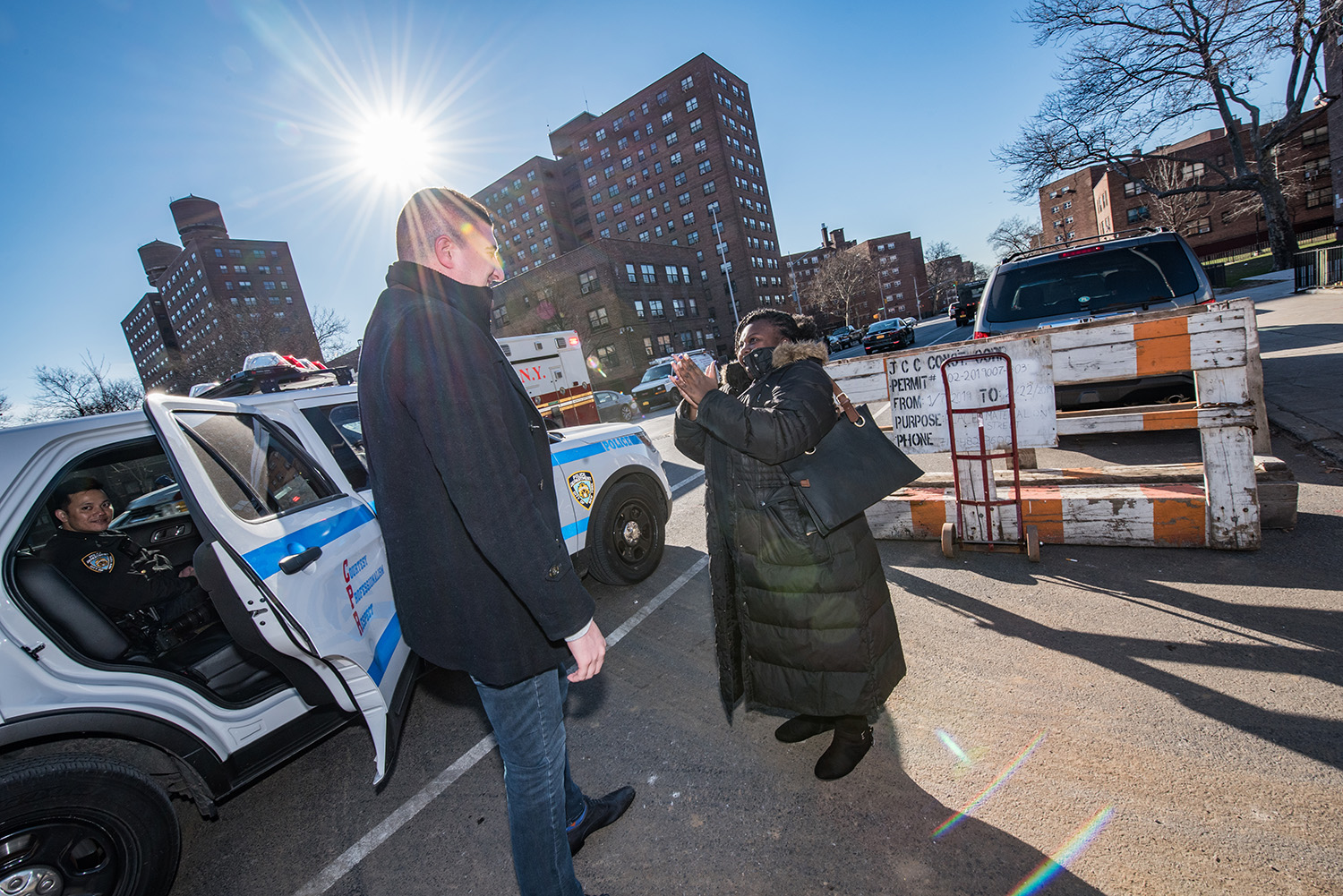
Asked if Jason was much of a basketball player, John didn't sugarcoat his assessment: "Far from it."
Though Jason and John had been paired seemingly at random, they connected at once, and both embraced the concept of Neighborhood Policing. The basketball court at Van Dyke Houses was known as "the Hole," because it is below ground. Though the design allows for tiers of seats for spectators, it also collects trash, wind-blown and human-thrown.
Jason and John started hanging out at the Hole, and spending time at the Van Dyke Community Center. There was some resistance from some quarters, at first‐John said, "A few guys said, 'Screw you,' and that's the nice version,"‐but their openness and commitment were noticed and appreciated almost at once. John went on, "People saw we weren't just there to write summonses. We're not just here for the negative. We're here for the positive, too." His athletic prowess was an asset, but his partner's lack of it may have won over teenagers even faster. Jason knew that with every game he lost, he made new friends: "The kids loved playing against me, beating me all the time. It was a pleasure to lose."
And they met Coach Mack, who was working at Van Dyke then. The three began to talk about how to set up something more structured and sustainable than hanging out at the Hole. They wanted to reduce the level of animosity between the developments, and to strengthen bonds between the police and the community. For cops to play ball with kids was a fine thing, but its impact was likely to be limited. It was easy to get the boys onto the court; the hard part was to keep their photos from going up on the wall at PSA 2. Mack, John, and Jason decided that there would be a price of admission to the game, and that the kids would have to play against teams that were not of their choosing.
The thinking was, as John put it, "We can get them through basketball, but we can take it to another level."
That was how the Unite Brownsville Cornerstone League (UBCL) was created, over three years ago. When its three primary founders are asked how it came about, and who had the idea for what, each credits the others more than themselves, which may be why the program has thrived. Mack, John, and Jason were all quick to point out that Dr. Saundra Johnson, director of the Cornerstone community center at Van Dyke Houses, made contributions that were at least as significant as their own. Cornerstone, which provides a variety of youth services, is run by Medgar Evers College and is funded by the New York City Department of Youth and Community Development (DYCD).
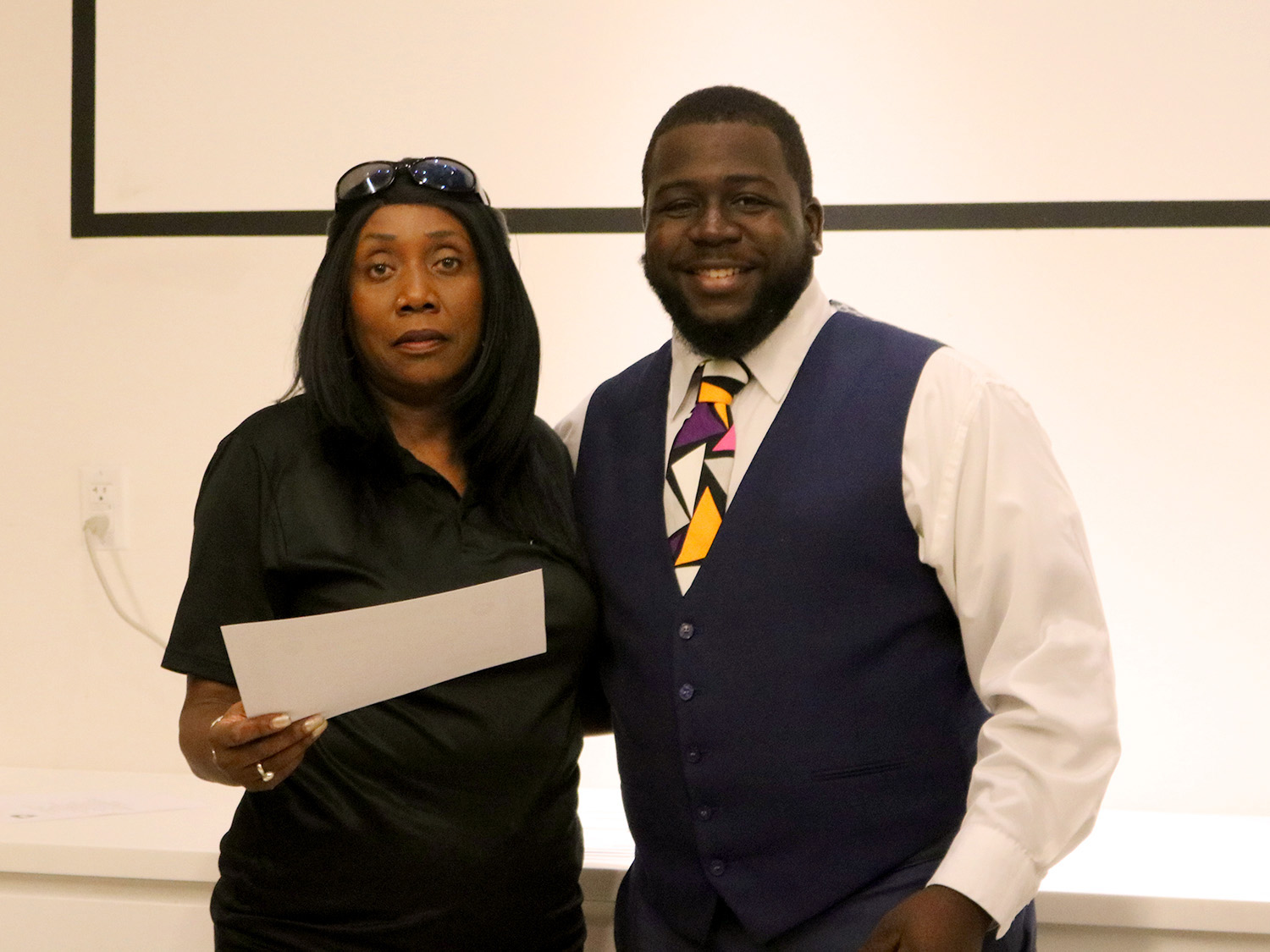
The new league made kids from different projects cross streets that they wouldn't have otherwise crossed. Brownsville played Howard, and Low played Garvey. Not always: feuds sometimes prompted tactical postponements of certain match-ups. The games were never played outside, and they were always under close supervision by John, Jason, and the other NCOs, who were armed and in uniform. They took kids out to eat, and arranged for trips to the Barclays Center and Madison Square Garden. To participate, the kids had to attend workshops on emotional intelligence, bullying, and gang recruitment. There were tutoring programs and SAT prep, classes in etiquette—how to dress for a job interview, for example. "The streets don't have anything to offer you but jail or death," Mack told them. At the same time, "You don't have to leave the neighborhood to leave the neighborhood, if that makes sense."
"People said we were crazy," John said, referring to critics both within the NYPD and without. They wanted to recruit at-risk kids, who were already well on the way down the wrong road: "We weren't just going after the easy targets."
Cops complained to him about seeing kids on the court they'd arrested for gun possession or robbery. And kids complained about the programs, "It's like extra school!"
But the program had the strong backing of Chief James Secreto, the commanding officer of the Housing Bureau, and a variety of community partners soon became equally enthusiastic. Support of all kinds began to pour in, once it began to be known that UBCL was run by people who were as hard-headed as they were hopeful. Mack, John, and Jason were careful about the kids they let in, but they wouldn't keep anyone out because of a criminal record. Compliance and conduct were what mattered, and infractions were considered case by case. If a kid was arrested for smoking marijuana, he might be allowed to stay; if he threatened a ref or fought with another player, he'd be out.
"And then cops would say, 'You guys got it easy! You just play basketball!'" John said. "But you have to be on top of everything with these kids—school, grades, how they're doing in the programs. Jason is the hardest-working cop I know. And we were still cops, with a mission to complete. We were about to go to a game one night when the Anti-Crime sergeant put it over the air that there was a gun run. They were looking for the guy. Jason got a call from a community member that the kid with the gun was hiding inside a garbage can outside of Brownsville Houses."
An arrest was made, and John and Jason were in time for the game.
If it was a revelation for the kids to see the cops up close, the reverse was true as well. Poverty didn't just mean that these kids had fewer things or cheaper things; there were deprivations of ordinary experience that were at least as meaningful, as they shaped their expectations of what kind of lives they might lead. John recalled when a friend of the program arranged for a clothing donation. Socks and shirts and underwear were welcomed with greater gratitude than he'd anticipated, and gifts of suits and sport jackets were received with a confused reverence, as if the kids had seen such things on TV, but never expected to possess them themselves. After John took a group from the program to a Mets game on donated tickets, he was surprised to learn that they'd never been to a baseball stadium before. But he was stunned to discover, "They'd never even been to Queens!"
For Jason, the culture shock was less, but the experience was still revelatory. When one of his star players seemed unusually withdrawn one day, he sat the boy down for a talk. Jason had noticed that he often seemed hungry, and his clothes weren't the cleanest, but those are hardly atypical qualities for an adolescent. Jason said, "He was a great kid, one of my favorites—always the first kid in the gym, the last kid out. Very respectful, and he played his ass off on the court. Great in workshop."
What Jason didn't know was that the boy was homeless. He'd been living with his mother in a shelter for the last two years. Through his community partners, Jason was able to arrange for a social worker to be assigned to the family. The mother was enrolled in two vocational training programs, and she has since found a job. Now, the family is out of the shelter, and in an apartment of their own. For the boy, seeing how his mother was able to change her life did wonders for his self-confidence. He's flourishing in high school, and he intends to go to college. Jason noted with pride that he's considering a career in law enforcement.
Another player approached Jason to confide that he'd been having arguments with his mother. Jason listened and offered ordinary advice to what seemed to be an ordinary problem: be patient, talk to her, try to see things from her point of view. As the conversation went on, it became clear that his trouble at home was related to trouble he was having on the street: he was being recruited into a gang. Together, Jason and the boy worked on a script: Hey, I respect you, but you know I can't ... It worked for the boy, who now assists Jason with the youth development programs.
With other participants in UBCL, Jason doesn't intrude in their personal lives, even though he might be tempted to do so. When he was told that the brother of one of his kids was killed by police, he wanted to make sure the young man knew that he was available to talk, if it would help. Jason didn't know anything about the circumstances of the death, when or where or why it happened. Indirectly, he was informed that the family preferred that the matter wasn't discussed. Jason accepted their decision. "He did well in the program, for three years," he said. "I think he's in college. The family moved down south."
When Jason talks, his language shifts between the careful optimism of social service—"We try to provide options in a place where there aren't enough options,"—with blunter cop-talk: "Brownsville can be a neighborhood where they swallow you whole."
Asked about a non-success story, Jason winced and said, "I don't want to talk about it." Then he did: There was a kid who shot his friend, maybe by accident. The friend lived, but he had fewer fingers after. John remembered the incident, as well: "You never would have expected that from this kid—he was a sweetheart!" The shooter did a couple of years in prison. Jason knew his family, and they remained on speaking terms. When the young man came home, Jason helped get him a job.
Had the young man learned his lesson? Time would tell.
*
After three years, there have been changes in the UBCL. In January 2018, John Seminerio was promoted to sergeant, and reassigned to a precinct in Queens. P.O. Terrance Zeng, who emigrated from China at the age of twelve and served in the Army before becoming a police officer, is now Jason's partner. The program has been expanded to East New York. Some of the first kids who enrolled in the program now serve as "Ambassadors," enlisting and mentoring new arrivals.
Now, when Jason walks through Van Dyke, he is greeted as politicians wish they were, besieged by sudden embraces and constant shout-outs: "Officer Jason! Officer Jason!"
Though the warmth he inspires is genuine, the familiarity can be partly attributed to the challenge of saying his last name, which is Basque in origin. At the front desk of PSA 2 recently, two of his fellow officers struggled with the pronunciation:
"You want Azaga-"
"Agazan-"
"Zagana-"
"Jason. You want Jason. I'll get him."
Over the summer, the UBCL took the kids to even stranger places than Queens. With the support of the New York City Police Foundation, a company called Street Smarts VR began to transform their experiences on the streets and playgrounds of Brownsville into a virtual reality training platform.
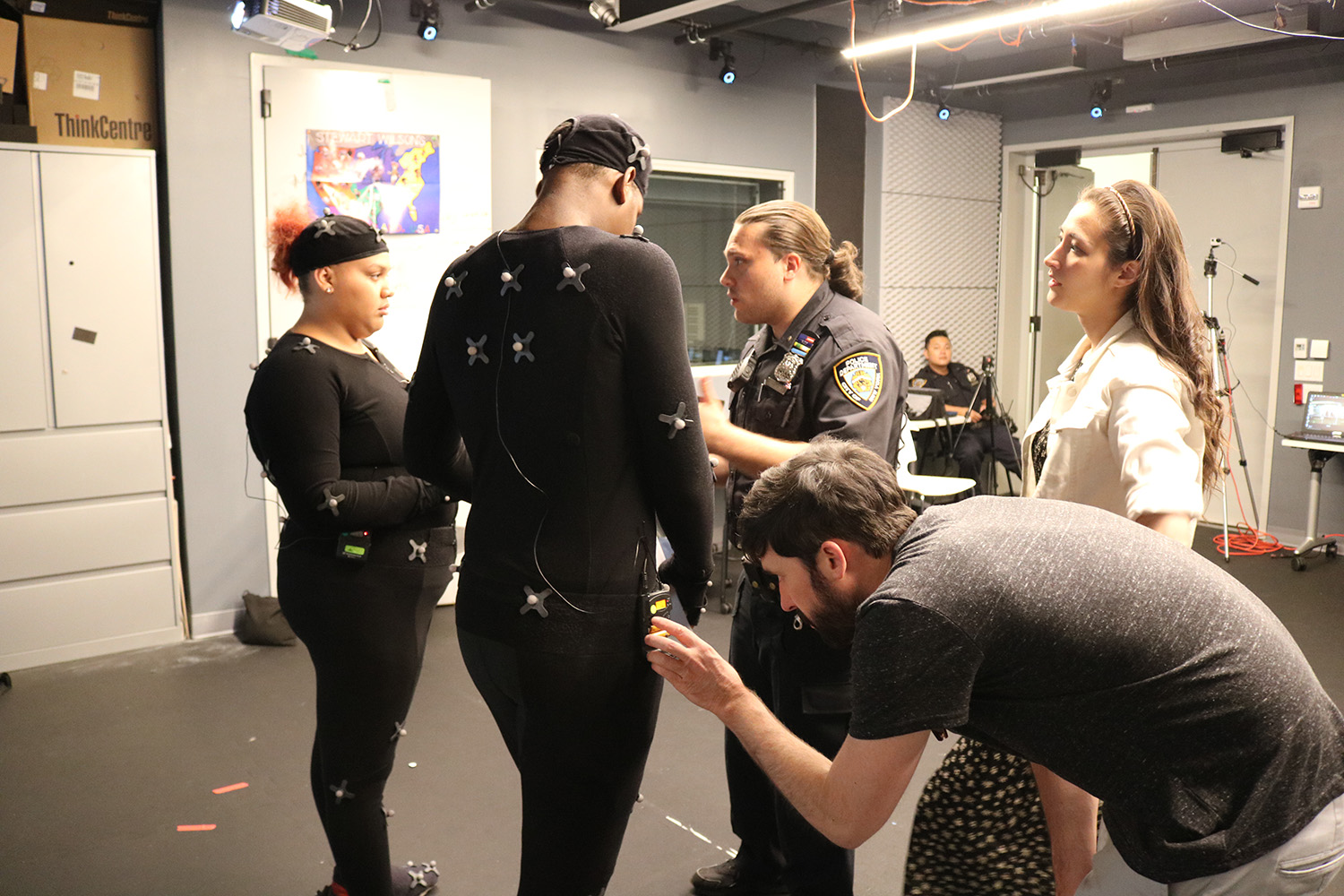
At a studio space in downtown Brooklyn one afternoon in July, Jason stood up and called "Action!" The studio was part of the NYU campus, in the Metrotech Center, an expansive room with an exposed ceiling and designer lights, walls of aqua and white. A crime drama was about to begin. "The kids came up with scenarios that were relevant to them," said Gregg Roberts, executive director of the Police Foundation.
It was a rehearsal for a kind of crime drama, to be precise, and costumes weren't necessary for either the four teenagers or P.O. Joseph Galletta, another NCO from PSA 2. Joe is pale and slightly built, and he wore cargo shorts and a T-shirt, black socks and black-framed glasses. He didn't appear to be either very cop-like or very criminal on first impression. He was very much a team player, though, even though he was playing for the other team.
When one of the teenagers threw a bandana to the ground, Joe offered a quiet note of remonstration: "He wouldn't throw his flag. It's disrespectful."
Heads nodded, on stage and off. The collaborative spirit was paramount: cops couldn't do this project without kids, and amateurs couldn't do it without artists and educators, technical and emotional. The script that was being rehearsed had been developed by the four teenagers, among others in the UBCL program, and it explored multiple scenarios of gang recruitment. The premise might be described as the reverse of a best-selling business book of the 1980's: instead of "Getting to Yes," the goal here was "Getting to No."
Joe played the bystander-friend role alongside Brian Skerret, an effusive 15-year-old with his hair up in a topknot. They were approached by three gang members: Ashley Garabitos, nineteen, in a white-lace top embroidered in roses, her pink hair also topknotted; Isaiah Miller, a lanky seventeen-year-old in a black hoodie and red sweatpants; and Nisean Flourney, a reedy thirteen-year-old in a gray hoodie and blue jeans. They were there to make Skerret one of their own, and they asked him to meet up with them later on.
When they stood fixed in position, two against three, a woman named Alice Formwalt urged them not to stay so still. A former EMT and firefighter who had designed flight simulations for the U.S. Air Force, she is a co-founder of Street Smarts VR.
"Play with the space," she said. "Move around a little. Remember, Brian, you don't want to be with them, but you have to play it cool."
Brian nodded, and his hands danced as he declined the offer to meet. "Yo, I can't. I got practice."
Ashley moved in closer, crowding him. "Who you play for?"
"The Devils."
You think you a ballllllll playa?" Ashley sneered, miming a three-pointer. "What you play?"
"Guard."
She cackled, "You like two hundred pounds, yo!"
The teens broke out laughing, and Alice chided gently, "You don't have to bully him so much."
But didn't she? In a later iteration, in which Brian offered a more blunt refusal, Ashley snapped at him—"Why you talking spicy, bro?"—before Isaiah threw a punch that might have had more oomph than was strictly necessary. Brian dove to the floor at the impact, only half-faking, and he was only half-faking irritation as he yelled, "It's supposed to be a push, dummy!"
"Word," said Joe, shaking his head.
Isaiah laughed, "I love how Officer Joe's talking like us now!"
Joe nodded and smiled. "I'm more excited than you guys."
The reason for his enthusiasm had to do with more than the pleasures of improvisation. A tech buff, he was thrilled as the performers moved to a studio next door, which was filled with computer equipment. Street clothes were traded for black sweatpants and long-sleeve shirts, as well as black booties and caps that stretched to cover topknots. Sensors were attached to various points on their frames for motion-capture computer animation.
"This is where the magic happens," said one of the tech guys, affixing sensors to elbows and feet.
"It isn't magic," said another. "It's science."
But none of the teenagers believed the second man. It was magic, and they knew it.
By January 2019, there would be six virtual reality scenarios developed, and twenty-five police commands were training officers to show kids how to use them, as part of a new program called "Options."
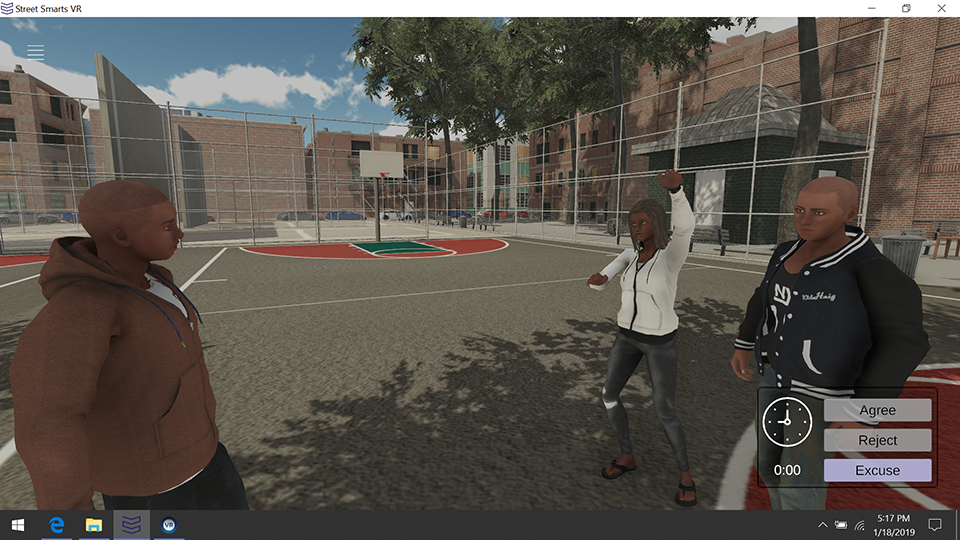
*
Running an enterprise like the UBCL requires an enormous amount of planning and effort. On an afternoon in early October, Jason and Mack met with several of their partners at the community room of Howard Houses: Duane Kinnon, a management consultant and the head of Friends of Brownsville Parks; Tyrell Morant, a community organizer who ran the East New York start-up of UBCL; and Jamel Watkins of DYCD. The room was painted pool-blue, and filled with art supplies, folded-up lunch-room tables and chairs, and posted admonitions against fighting, spitting, and screaming.
The men discussed the need to expand their roster of organizational supporters —at present, they include CAMBA, a Brooklyn-based social service agency, WellCare, a healthcare provider, PeacePlayers International, a group that promotes conflict resolution through sports, the Brownsville Community Justice Center, NYCHA, the NBA, DYCD, and Medgar Evers College, among others—without having "too many cooks."
"We're getting closer with Brooklyn College," said Duane. "I've submitted proposals for both sides of the program, athletic and tech."
Tyrell pointed out that there was HUD money available for programs for teens fourteen to seventeen years old, which happened to be the target age for the UBCL.
"Housing's paying for the awards dinner," added Mack. "We have to find neutral ground for it."
"I don't have shorts for East New York," Jason said. "It wasn't in the budget."
They went on to discuss the cost of jerseys, trophies and referees, the need to share rosters, and the importance of setting up orientation meetings for the coaches. There was discussion of laundry invoices—jerseys are collected after each game, so none would be lost, or worn when they weren't clean. There had been problems the past year with referees who didn't show up at games, and referees who showed up, but hadn't been paid.
There was a plan to have a cops-versus-kids game in East New York, but it was scheduled for a Monday, when most of the NCOs had the day off.
Jason wondered aloud, "If a cop gets hurt in the game, is it a line-of-duty injury?"
He went on to volunteer Brian and Ashley, two of his Ambassadors, to run the refreshment table.
Mack offered, "We can get the Gatorade powder, it's cheaper."
Several eyes turned to Jason, who looked down and said, "Don't ask me to make it."
Though no one seemed to have suffered too badly from the overabundance of electrolytes at a recent game, it was clear that no one wanted to repeat the experience. "It says it on the container," Mack noted drily, "Half a bottle makes ten gallons."
"That's why I became a cop," said Jason, sheepish. "I can't add."
Eager to change the subject, he pressed ahead with the agenda. "Let's talk about job placement. Gregg Roberts at the Police Foundation has connections with tech companies, colleges, banks. Some of the kids won't be eligible if they have criminal records."
Mack vented briefly about a different kind of exclusion: opportunities that were reserved for teens with arrest histories, such as a local tech and graphic design program. "I have kids who don't get into trouble—they go to school every day, with ninety-plus averages—and they can't get in!"
Heads nodded around the table. Coach Mack was right; they needed more, and they likely always would. Just before they got up from the table, Jason offered a brief and seemingly unexpected pep talk. "Know your role, always communicate," he said, fervor in his voice. "This is no single person's project. It's everybody's. It's really exciting for our kids."
*
Jason's last words of encouragement might have been for his own benefit. Earlier that morning, when asked when his toughest day as a police officer had been, he replied, "Just the other Friday."
On that day, ten days before, on a balmy afternoon, Jason and Terrance were working when the call came over the radio: 10-30, units, male shot, multiple calls... The location was at the Chester Playground, just a few blocks away. They raced to a scene of chaos and horror. A young man had been shot in the head while playing basketball with his friends. Police and medics arrived at once, but he couldn't be saved.
"His teammates were crying around him. Multiple people around him, just praying... It struck me so hard," Jason said, his voice raw with grief. "When I got home... I grabbed my daughter and told her, 'I love you so much, I will always be there to protect you.'"
Though the immediate impact was traumatic, what Jason later learned about the boy who died was devastating. Oluwadurotimi Joseph Oyebola, known as Timi, had moved with his family from Lagos, Nigeria, five years before. He lived with his parents in Jamaica, Queens, but he attended the Brooklyn Ascend Charter School, which was in the neighborhood, as was his church. He was spending a few hours on the basketball court before heading over to the Abundant Life Christian Center, where his father is a minister. Though Timi's passion was basketball, he was a gifted and dedicated student, with plans to become a doctor or an engineer. Friends described him as quiet, studious, and generous, with a sly sense of humor. He had recently won a national prize for academic performance, and the awards ceremony was to take place at Columbia University in November. He could not have been described as an "at-risk youth" in any sense of the term.
At the makeshift shrine that marked where Timi fell, there was a profusion of ribbons and flowers. White votive candles were set on the asphalt in front of his portrait, just below the hoop. In the picture, he's wearing a black baseball cap and a Navy blue T-shirt; he has a shy smile, but he looks directly at the camera. Posters covered the chain-link fence. These were some of the messages on them: "Stop Gun Violence!"
"Don't Shoot! I want to grow up!"
"Young lives matter!"
"Choose love!"
"Spread Positivity"
"He is in a better place."
"Protect kids, not guns"
"Enough is enough"
"May you sleep in peace angel"
"Fly high!"
There were lots of pictures of hearts, and even more of basketballs. The hashtag, "#E4T," was on many posters. A few noted the bitter brevity of the dates: 2002-2018.
Jason saw a woman sitting on a nearby bench, and he sat down to talk with her. She taught at the school next door, and she often took breaks in the playground. "You see cops chasing people all the time. You don't notice it. There's someone running, and then someone running after. Sirens. It's normal. And then… it hurts."
A little later, Jason saw another woman taking a slow walk through the shrine. He recognized her. He approached and said, "You were here."
She nodded. "My son was here. He took off his shirt and tried to stop the bleeding. The next day, me and my husband came back to leave candles, flowers. There was still blood on the ground."
The woman wondered if there was a way to protect the posters from the elements. It was supposed to rain later. She looked up at the sky and said, "I don't know how long it's gonna last."
The next day, on October 3rd, an arrest was made. The shooting was believed to be gang-related, and Timi was not the intended target. The wanted poster described the perpetrator as standing 5'4" and weighing 120 pounds. He was fourteen years old.
*
Jason talked with his UBCL kids about Timi, which may have helped him as much as it did them. Some were more accustomed to sudden loss than he was, and the way they managed to move on was heartening. But it was also infuriating that they had already learned these lessons, sometimes more than once. It shouldn't be ordinary, or expected, that lives of such potential could have such mean and meaningless endings. There had to be a better way, and Coach Mack, Terrance, and Jason had dedicated themselves to finding it.
It wasn't as if Jason had started out as an NCO with an easy idealism that cracked at the first hard contact with the reality of the streets of Brownsville. Reminders of violence were everywhere. Stopping for a sandwich at the Mucho Loco grocery, which had a Plexiglass security window for late night sales, Jason gestured toward the corner. "An old man got punched in the head right there, fell down and died."
Driving through the neighborhood, Jason and Terrance pointed out the sites of other recent incidents: "That's where the girl drove over the dude with the moped."
"Here's where the kid got stabbed."
"We had somebody jump off the roof there the other day, split himself in half."
At a custom clothing shop that did embroidery and screen printing, they checked on an order of basketball jerseys. Inside, there were bomber jackets with the logo of the Black Panther movie on display, blue blazers and windbreakers with the insignia of nearby schools, and memorial T-shirts: "Sunrise April 4, 1991 Sunset February 13, 2016."
But it would be misleading to describe any awful act as "the" reality of Brownsville. Mostly, Jason was thrilled by the sense of possibility of the people there, and he was routinely almost knocked over—literally—by the spontaneous expressions of gratitude he encountered. At the Van Dyke Playground, with its brick-red and highway-yellow swing-sets and slides, he beamed as he showed off the new benches his kids had built. The paint was still new.
Hundreds of kids have taken part in UBCL, more than there were on the gang wall at PSA 2. But Jason would caution against seeing one group as saved, the other as lost. They were still young, with choices to make. He stared at one of the faces on the wall for a moment and said, "He went through the program, he did good. He's away in college now."
Asked if the picture still belonged there, Jason nodded.
"He's doing great in a lot of ways, when he's away. But when he's in the neighborhood, he's right back with the old crowd."
Time would tell. Everything Coach Mack, Jason and the rest of their partners did for the boys—coaching, teaching, counseling—could be described as buying time. Kids who don't believe in their futures are less likely to have them.
"It's a principle of youth development that you can't save every life," Mack later observed. "In this neighborhood, we have parents who are always working, and parents who aren't there. But the more the kids want to be here, the more lives we can save."
In December 2018, four days before Christmas, Jason was promoted to the rank of detective. Though he treasured his gold shield, the occasion reminded him of other gifts he'd been given over the course of the past three years: "Three kids I have right now want to be cops. 'Just like you,' they said. That's how I know I did my job."
